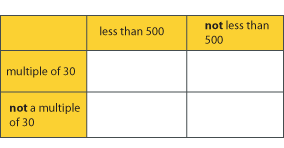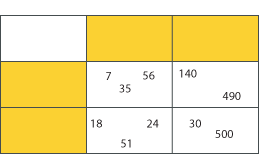Example review questions
- Write one number in each of the white sections of the diagram.
- Put these numbers in the correct sections.
60, 742, 1180, 390, 530 - Describe the numbers that could go in each of the white sections.

 Handling data
Handling data
This teaching guidance document suggests some of the key vocabulary, models, images and practical equipment that children should experience and be able to use. It also includes some teaching tips to provide a few starting points for ways of supporting children with this area of mathematics.
![]() Can I sort and interpret data in Venn and Carroll diagrams? - teaching guidance | 25KB
Can I sort and interpret data in Venn and Carroll diagrams? - teaching guidance | 25KB 
These resources are to support children in guided or independent work.
Possible contexts include:
Ask probing questions such as:
